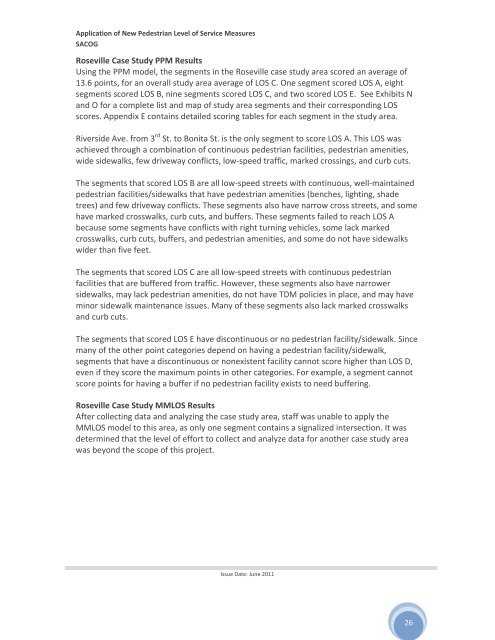Application of New Pedestrian Level of Service Measures - sacog
Application of New Pedestrian Level of Service Measures - sacog
Application of New Pedestrian Level of Service Measures - sacog
You also want an ePaper? Increase the reach of your titles
YUMPU automatically turns print PDFs into web optimized ePapers that Google loves.
<strong>Application</strong> <strong>of</strong> <strong>New</strong> <strong>Pedestrian</strong> <strong>Level</strong> <strong>of</strong> <strong>Service</strong> <strong>Measures</strong><br />
SACOG<br />
Roseville Case Study PPM Results<br />
Using the PPM model, the segments in the Roseville case study area scored an average <strong>of</strong><br />
13.6 points, for an overall study area average <strong>of</strong> LOS C. One segment scored LOS A, eight<br />
segments scored LOS B, nine segments scored LOS C, and two scored LOS E. See Exhibits N<br />
and O for a complete list and map <strong>of</strong> study area segments and their corresponding LOS<br />
scores. Appendix E contains detailed scoring tables for each segment in the study area.<br />
Riverside Ave. from 3 rd St. to Bonita St. is the only segment to score LOS A. This LOS was<br />
achieved through a combination <strong>of</strong> continuous pedestrian facilities, pedestrian amenities,<br />
wide sidewalks, few driveway conflicts, low‐speed traffic, marked crossings, and curb cuts.<br />
The segments that scored LOS B are all low‐speed streets with continuous, well‐maintained<br />
pedestrian facilities/sidewalks that have pedestrian amenities (benches, lighting, shade<br />
trees) and few driveway conflicts. These segments also have narrow cross streets, and some<br />
have marked crosswalks, curb cuts, and buffers. These segments failed to reach LOS A<br />
because some segments have conflicts with right turning vehicles, some lack marked<br />
crosswalks, curb cuts, buffers, and pedestrian amenities, and some do not have sidewalks<br />
wider than five feet.<br />
The segments that scored LOS C are all low‐speed streets with continuous pedestrian<br />
facilities that are buffered from traffic. However, these segments also have narrower<br />
sidewalks, may lack pedestrian amenities, do not have TDM policies in place, and may have<br />
minor sidewalk maintenance issues. Many <strong>of</strong> these segments also lack marked crosswalks<br />
and curb cuts.<br />
The segments that scored LOS E have discontinuous or no pedestrian facility/sidewalk. Since<br />
many <strong>of</strong> the other point categories depend on having a pedestrian facility/sidewalk,<br />
segments that have a discontinuous or nonexistent facility cannot score higher than LOS D,<br />
even if they score the maximum points in other categories. For example, a segment cannot<br />
score points for having a buffer if no pedestrian facility exists to need buffering.<br />
Roseville Case Study MMLOS Results<br />
After collecting data and analyzing the case study area, staff was unable to apply the<br />
MMLOS model to this area, as only one segment contains a signalized intersection. It was<br />
determined that the level <strong>of</strong> effort to collect and analyze data for another case study area<br />
was beyond the scope <strong>of</strong> this project.<br />
Issue Date: June 2011<br />
26
















